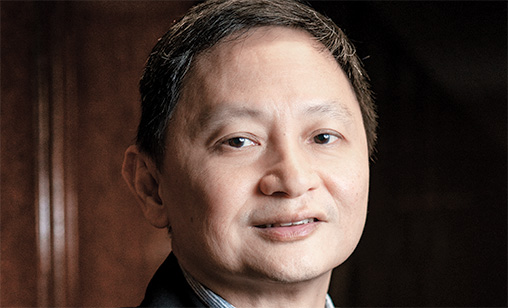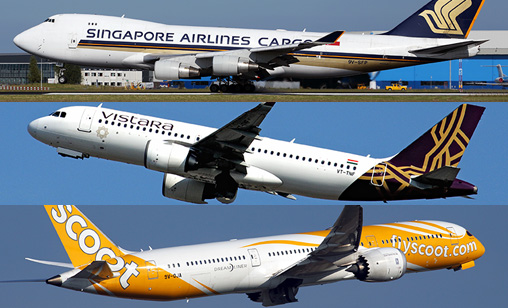News Backgrounder
Fitter for future from facing COVID-19 challenges, says SIA
While surviving COVID-19 is priority number one for Asia-Pacific carriers, the region’s industry should grab opportunities as it emerges from the pandemic believes Singapore Airlines Group CEO, Goh Choon Phong. Associate editor and chief correspondent, Tom Ballantyne, reports.
December 1st 2020
Singapore Airlines (SIA) Group may have reported its biggest ever quarterly loss last month, a net deficit of $1.7 billion, but CEO, Goh Choon Phong, did not show any signs of being disheartened when he announced the results. Read More »
In fact, he is convinced the SIA group is in a better position than any other airline in the world to successfully negotiate the crisis. “We strongly believe SIA will be much stronger and fitter from this crisis,” he said.
 |
| 'When you talk about sustainability for airlines you can’t run away with just talking about carbon emissions from operating the planes. To be absolutely frank, the most effective way for any airline to reduce your carbon emissions when operating your planes is to ensure you have fuel efficient planes' |
| Goh Choon Phong SIA group CEO |
“We have four key foundations that are not common among all airlines. We have a strong and trusted brand. We have strong liquidity and therefore a strong balance sheet. Our people are very committed, very passionate, talented and highly skilled. And in the last few years, as a result of our previous transformation, we have established ourselves as one of the leading digital airlines in the world.”
With that foundation, Goh said, the carrier had launched “a new transformation chapter” focused on continuing to be a leader in product and services post COVID-19. “We will achieve the financial stability needed to reward our shareholders and to reinvest for our growth. And, of course, we will continue to ensure the SIA spirit remains high and alive and our people have the skill set for the future,” he said.
Goh, speaking to analysts and media in an online briefing following the release of its third quarter results, to September 30, said liquidity is the most important requirement for airlines and stressed it was not an issue for the carrier.
At press time, the airline group announced it had raised an additional S$500 million (US$373 million) via a private placement of new 10-year bonds at an interest rate of 3.5% per year. The proceeds would be used for general purposes, including refinancing of existing borrowings, the airline said.
In June, the company raised $6.5 billion in a rights issue, $1.5 billion from financing of aircraft and increased its committed lines of credit by another $372 million. “Bear in mind the $1.3 billion in committed lines of credit that was pre-existing before the COVID-19 crisis is largely unutilized at this moment,” Goh said.
“We are not stopping here. We are increasing our efforts to look at more sources of raising liquidity. We have entered discussions, [now] at an advanced stage, to do complete lease-back transactions and we are looking at tapping the debt capital markets. With all this we believe we will have one of the strongest liquidity positions, if not the strongest, among airlines.”
Efforts to overcome the pandemic crisis were not just about liquidity, they also are about cost management, Goh said. One was “the painful exercise” in September when the airline had to cut 4,300 staff positions. Another has been the removal of 26 older aircraft from the fleet: eight 777s, seven A380s, nine A320s and two A319s. Negotiations with Airbus about aircraft orders have been completed and similar negotiations were in an advanced stage with Boeing, he said.
Goh did not say if the discussions involved order cancellations or delivery deferrals. Beyond managing costs and liquidity, SIA was trying to seize revenue opportunities in the market. “We continue to push boundaries and grow new businesses that are adjacent to what we are doing,” he said.
Among them is just launched Pelago, a trip planning platform marketed as a “destination discovery platform”. It offers activities, experiences and attraction tickets in Singapore, including theme park admission, food and drink tours and wellness treatments. The SIA Academy has opened its doors to train people from other industries and already more than 50 organizations have expressed interest in working with the airline group.
 |
“These are relatively new ventures and we are in the midst of crisis so it is premature to provide any guidance or projections on the revenue we might expect from new ventures. Obviously, as the market recovers and the business comes back we will be able look forward to something more material,” Goh said.
In the midst of all this, the SIA group CEO stressed airlines must keep their sustainability goals front and centre. SIA’s fleet, with an average of six years, is way ahead of the global average of more than 15 years. “Our experience, especially for long-haul flights, is with these modern planes, technology, engines in particular, and fuels and design, we have fuel efficiency of close to 30%. This gives us substantial savings in carbon emissions,” he said.
The company also is installing solar panels on all its buildings, saving 2,300 tonnes of carbon emissions per year. Another innovation, just launched, is a dining concept for Premium Economy and Economy using paper boxes and bamboo cutlery. The menu and serving presentation will reduce the weight carried on board by almost 16%, contributing to lower fuel burn and annual savings of more than 300 tonnes of carbon emissions.
“The efforts we have put in to ensure a strong digital capability have produced good results by allowing us to very quickly introduce digital solutions to ease the travel experience for our customers. It also allows contactless interactions. For example, on board they can use their personal devices to control the IFE to avoid touching screens or handsets,” he said.
“I think everyone will agree Singapore is probably among the most proactive nations in the world when seeking to open up and reduce travel restrictions in a safe manner for our customers.”
Goh added some strategies being pursued before COVID -19 were benefitting the airline group. “SilkAir’s integration back into SIA is one such initiative. So we can expect SIA to operate its first narrow-body planes by the first quarter of next year. This will give us the flexibility to operate wide-body or narrow-body operations on routes, depending on demand, seamlessly.
“Similarly, for Scoot, we can deploy the right vehicle to the right market in response to the passenger profile of that market. We invested in Vistara in India because it allowed us to participate in the growth of another major market in which SIA cannot currently participate. Vistara today is operating 55% of its pre-pandemic domestic capacity. It expects to reach 60% by year-end and 100% of its pre-COVID-19 domestic capacity by April.”
The pandemic has been difficult for all airlines but especially for an airline such as SIA because it does not have a domestic market. “But even in this difficult time we have not forgotten and we have not let up in our engagement with key stakeholders. We continue to participate in community projects and initiatives,” he said. This has included the group’s cargo division transporting humanitarian aid to countries in need and an Ambassador program, under which staff such as cabin crew have been contributing to Singapore’s fight against the virus outbreak.
In the end, however, Goh said it is not just about managing the crisis itself. “In parallel, we have been preparing ourselves to emerge stronger and fitter from this crisis.”